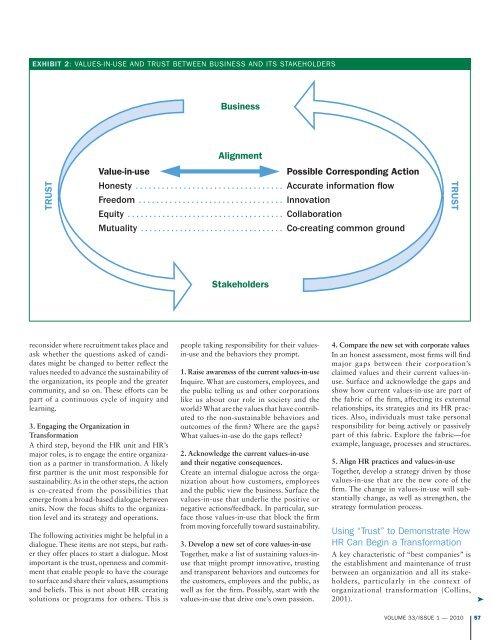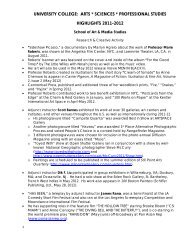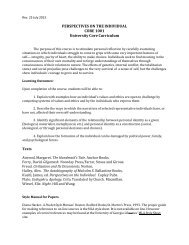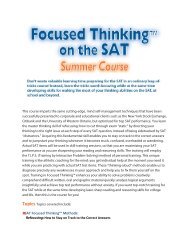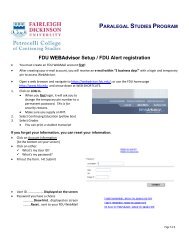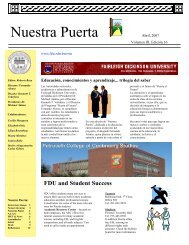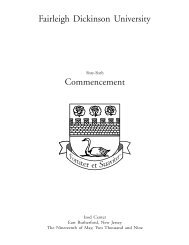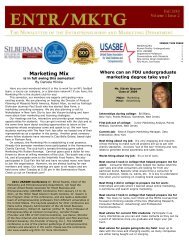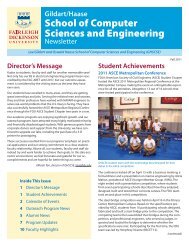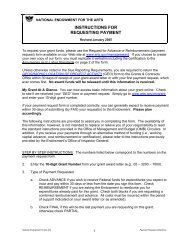Can Green Swim Upstream? - FDU
Can Green Swim Upstream? - FDU
Can Green Swim Upstream? - FDU
You also want an ePaper? Increase the reach of your titles
YUMPU automatically turns print PDFs into web optimized ePapers that Google loves.
ExHIBIT 2: VALUES-IN-USE AND TRUST BETWEEN BUSINESS AND ITS STAKEHOLDERS<br />
TRUST<br />
reconsider where recruitment takes place and<br />
ask whether the questions asked of candidates<br />
might be changed to better reflect the<br />
values needed to advance the sustainability of<br />
the organization, its people and the greater<br />
community, and so on. These efforts can be<br />
part of a continuous cycle of inquiry and<br />
learning.<br />
3. Engaging the Organization in<br />
Transformation<br />
A third step, beyond the HR unit and HR’s<br />
major roles, is to engage the entire organization<br />
as a partner in transformation. A likely<br />
first partner is the unit most responsible for<br />
sustainability. As in the other steps, the action<br />
is co-created from the possibilities that<br />
emerge from a broad-based dialogue between<br />
units. Now the focus shifts to the organization<br />
level and its strategy and operations.<br />
The following activities might be helpful in a<br />
dialogue. These items are not steps, but rather<br />
they offer places to start a dialogue. Most<br />
important is the trust, openness and commitment<br />
that enable people to have the courage<br />
to surface and share their values, assumptions<br />
and beliefs. This is not about HR creating<br />
solutions or programs for others. This is<br />
Business<br />
Alignment<br />
Value-in-use<br />
Possible Corresponding Action<br />
Honesty . . . . . . . . . . . . . . . . . . . . . . . . . . . . . . . . . . Accurate information �ow<br />
Freedom . . . . . . . . . . . . . . . . . . . . . . . . . . . . . . . . . Innovation<br />
Equity . . . . . . . . . . . . . . . . . . . . . . . . . . . . . . . . . . . . Collaboration<br />
Mutuality . . . . . . . . . . . . . . . . . . . . . . . . . . . . . . . . . Co-creating common ground<br />
Stakeholders<br />
people taking responsibility for their valuesin-use<br />
and the behaviors they prompt.<br />
1. Raise awareness of the current values-in-use<br />
Inquire. What are customers, employees, and<br />
the public telling us and other corporations<br />
like us about our role in society and the<br />
world? What are the values that have contributed<br />
to the non-sustainable behaviors and<br />
outcomes of the firm? Where are the gaps?<br />
What values-in-use do the gaps reflect?<br />
2. Acknowledge the current values-in-use<br />
and their negative consequences.<br />
Create an internal dialogue across the organization<br />
about how customers, employees<br />
and the public view the business. Surface the<br />
values-in-use that underlie the positive or<br />
negative actions/feedback. In particular, surface<br />
those values-in-use that block the firm<br />
from moving forcefully toward sustainability.<br />
3. Develop a new set of core values-in-use<br />
Together, make a list of sustaining values-inuse<br />
that might prompt innovative, trusting<br />
and transparent behaviors and outcomes for<br />
the customers, employees and the public, as<br />
well as for the firm. Possibly, start with the<br />
values-in-use that drive one’s own passion.<br />
TRUST<br />
4. Compare the new set with corporate values<br />
In an honest assessment, most firms will find<br />
major gaps between their corporation’s<br />
claimed values and their current values-inuse.<br />
Surface and acknowledge the gaps and<br />
show how current values-in-use are part of<br />
the fabric of the firm, affecting its external<br />
relationships, its strategies and its HR practices.<br />
Also, individuals must take personal<br />
responsibility for being actively or passively<br />
part of this fabric. Explore the fabric—for<br />
example, language, processes and structures.<br />
5. Align HR practices and values-in-use<br />
Together, develop a strategy driven by those<br />
values-in-use that are the new core of the<br />
firm. The change in values-in-use will substantially<br />
change, as well as strengthen, the<br />
strategy formulation process.<br />
Using “Trust” to Demonstrate How<br />
HR <strong>Can</strong> Begin a Transformation<br />
A key characteristic of “best companies” is<br />
the establishment and maintenance of trust<br />
between an organization and all its stakeholders,<br />
particularly in the context of<br />
organizational transformation (Collins,<br />
2001).<br />
➤<br />
VOLUME 33/ISSUE 1 — 2010 57


